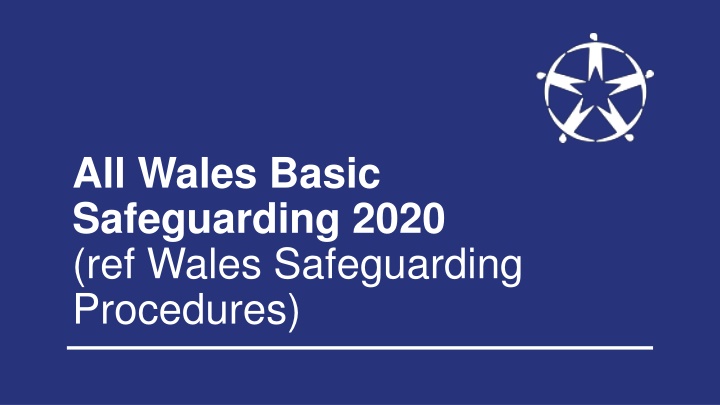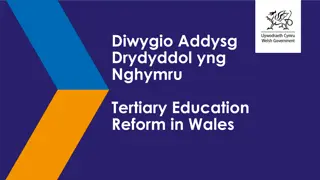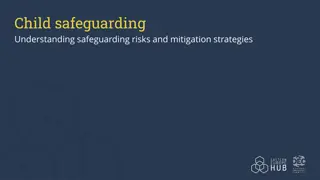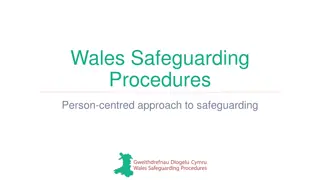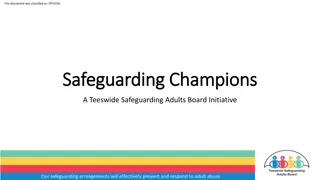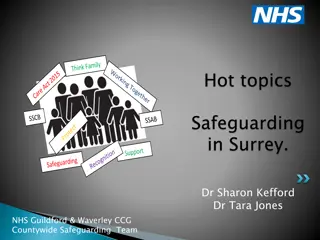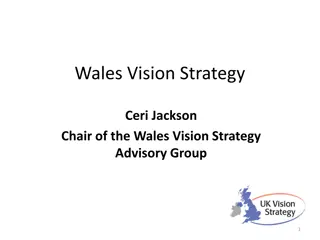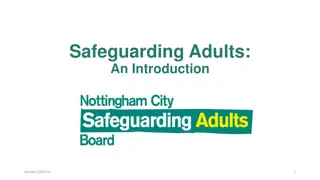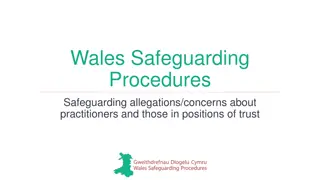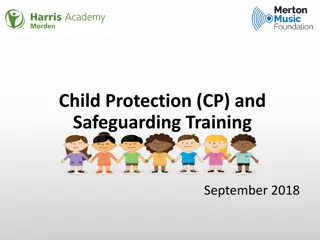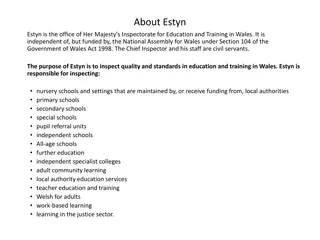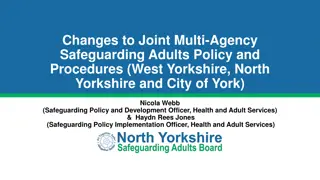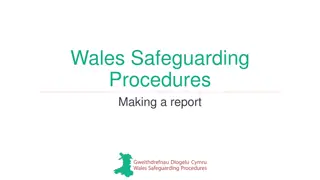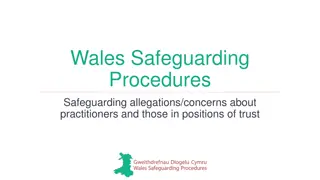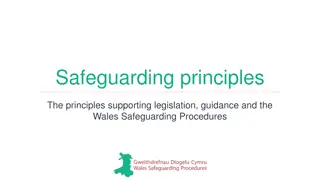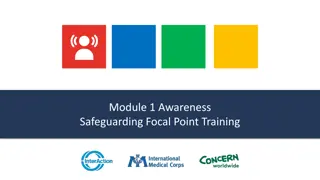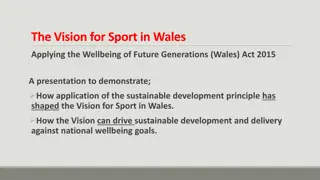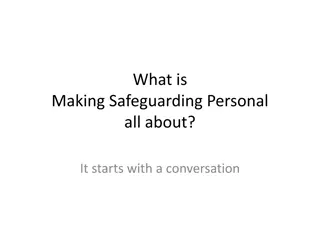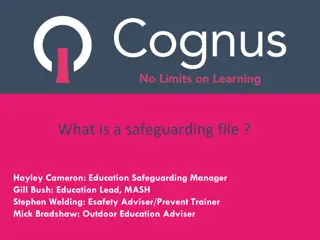All Wales Basic Safeguarding Overview
This overview provides insights into the All Wales Basic Safeguarding 2020, emphasizing key principles, learning outcomes, and activities related to safeguarding adults and children from abuse. It highlights the importance of understanding roles, recognizing various types of harm, and implementing safeguarding procedures in Wales. The content covers housekeeping guidelines, safeguarding principles, and practical exercises to reinforce practitioners' responsibilities in ensuring the well-being of vulnerable individuals.
Download Presentation

Please find below an Image/Link to download the presentation.
The content on the website is provided AS IS for your information and personal use only. It may not be sold, licensed, or shared on other websites without obtaining consent from the author.If you encounter any issues during the download, it is possible that the publisher has removed the file from their server.
You are allowed to download the files provided on this website for personal or commercial use, subject to the condition that they are used lawfully. All files are the property of their respective owners.
The content on the website is provided AS IS for your information and personal use only. It may not be sold, licensed, or shared on other websites without obtaining consent from the author.
E N D
Presentation Transcript
All Wales Basic Safeguarding 2020 (ref Wales Safeguarding Procedures)
Overview Housekeeping Timings, respect, comfort, confidentiality, participation Implementing the Wales Safeguarding Procedures (under the Social Services and Well-Being (Wales) Act 2014) Any issues from today s training
Learning outcomes This training will give participants the opportunity to: know their own role in relation to safeguarding adults and children and young people from abuse, neglect and harm understand how individuals are protected from abuse, neglect and harm know how to recognise and report different types of abuse, neglect and harm know the expectations placed on all practitioners to deliver the Wales Safeguarding Procedures
Download the app Wales Safeguarding Procedures
Safeguarding principles The principles supporting legislation, guidance and the Wales Safeguarding Procedures
Activity 1: Principles Use of app or Use of cards Discuss the importance of these principles in safeguarding
Key values Two key values in safeguarding practice 1: Safeguarding is everybody s responsibility 2: A child-centred/person-centred approach
Six safeguarding principles practitioners: Principle 1 Put the wishes, needs and well-being of the child/desired outcomes of the adult at risk first Principle 2 Are alert to the needs of children/adults at risk (including any potential or suspected abuse or risk of abuse or harm) and understand what action they should take Principle 3 Share appropriate information and have direct access to advice to discuss any concerns about a child/adult
Six safeguarding principles practitioners: Principle 4 Able to use their professional judgment to work with the child s/adult s needs and personal outcomes Principle 5 Work in a multi-agency and co-operative way, record decisions appropriately and regularly review progress Principle 6 Supported by leaders/managers to achieve the desired outcomes for the individual
Safeguarding is everybodys responsibility Each practitioner and organisation must: contribute to safeguarding and promoting the well-being of the individual share information following data protection guidelines work with practitioners within your team and other agencies to better understand the individual, their circumstances and their needs develop co-productive working relationships with the individual at risk, their family and carers to establish what matters to them and to ensure they feel respected and informed.
All practitioners should: understand their safeguarding role and responsibilities follow their organisation s safeguarding procedures and protocols understand their duty to report/act be alert to indicators of abuse and neglect to the child/adult at risk have received training appropriate to their role and responsibilities understand the safeguarding process contribute as necessary at all stages of the safeguarding process
Safeguarding tasks The practitioner has two tasks: 1) to prevent situations where an individual may experience abuse, neglect and harm and if this is not effective 2) to identify emerging concerns about abuse, neglect and harm to the child/adult at risk
Designated Safeguarding Person (DSP) The person in an organisation who: is available to discuss safeguarding concerns you should consult about raising safeguarding concerns with social services will manage any immediate actions to ensure the child at risk is safe from harm All practitioners must know who to contact in their agency for advice All practitioners shouldnot hesitate to discuss their concerns, no matter how insignificant they think they are
Activity 2 What is acceptable? Do you think this child/adult is at risk?
Activity 3 Using the app or write down in small groups: Find/discuss the definition of safeguarding Find/discuss the definition of at risk for child or adult, whichever group you work with the most
Safeguarding adults at risk Safeguarding involves: preventing and protecting adults at risk from abuse or neglect educating people around them to recognise the signs and dangers of abuse and neglect promoting their well-being One important difference between safeguarding adults and safeguarding children is an adult s right to self-determination. Adults may choose not to act at all to protect themselves
Adult at risk Anyone aged 18 years or over who: is experiencing, or is at risk of experiencing, abuse or neglect and has care and support needs (whether or not the local authority is meeting any of those needs) and as a result of those needs is unable to protect themselves against abuse or neglect or the risk of it
Safeguarding Taking action to promote the welfare of children and protect them from harm protecting children from abuse and harm preventing harm to children s health or development taking action to support children and young people to have the best outcomes ensuring children grow up with safe and effective care
Child The Social Services and Well-being (Wales) Act 2014 and accompanying guidance define a child as a person who is aged under 18
Child at risk A child who: is experiencing or is at risk of experiencing abuse, neglect or other kinds of harm and has care and support needs (whether or not the local authority is meeting those needs)
Compare the two definitions What does this mean?
The duty to report The duty to report a child or adult at risk of abuse, neglect and/ or harm
Who has a responsibility to report? We all do! You have a responsibility to contactsocial services or the police if you know or have concerns or suspicions that a child: is experiencing abuse, neglect or other kinds of harm has experienced abuse, neglect or other kinds of harm is likely to be at risk of abuse, neglect or other kinds of harm This is not a matter of personal choice
Statutory duty to report Statutorymeans it s required by law. The Social Services and Well-being (Wales) Act 2014 says relevant partners of the local authority are: other local authorities the police, probation and youth justice services education (and all other local authority departments) local health boards and NHS trusts and have a statutory (legal) responsibility to report if they have reasonable cause to suspect adults and children, including unborn children, are at risk of abuse
Non-statutory responsibility to report Anyone who is not a relevant partner must still report any safeguarding concerns they have in the same way as those with a statutory duty to report Safeguarding is everyone s responsibility!
Activity 4 What factors suggest that individuals known to your service could be at risk ?
Activity 4: Increased risk of abuse, neglect and harm due to: experiencing needs for care and support limited or lacking verbal communication lacking capacity and understanding unaware of their rights suffering institutional poor practice or institutionalised low self-esteem/self-worth living away from the family home, such as in care domestic abuse, drug/alcohol misuse in close relationships disability (mental or physical) isolated family or individual previous abuse or neglect experienced
Legislation and guidance
Legislation Social Services and Well-being (Wales) Act 2014: Any practitioner working with: an individual who has, or may have, care and support needs a carer who has, or may have, support needs children (who are looked after) must put the person s rights and best interests first consider the person s views, wishes and feelings promote and respect the person s dignity respectthe person s characteristics, culture and beliefs support the person to be involved in decisions that affect them
The Social Services and Well-being (Wales) Act 2014 Part 7 Safeguarding Working Together to Safeguard People Code of Practice under Part 10 of the Social Services and Well-being (Wales) Act 2014 The Mental Capacity Act 2005 The European Convention of Human Rights, particularly Articles 2,3,5,6 and 8 The United Nations Principles of Older Persons The United Nations Convention on the Rights of the Child Welsh Language Standards and the More than Just Words Framework
Child-centred approach See and speak to the child Aim to establish trust so that the child can be open and honest Understand their daily life experience Aim to understand what a typical day looks like Establish what they would like to see change in their daily lives Aim to understand what the child wants as an outcome Put the child s safeguarding interests over their wishes when needed Aim to ensure what s best for the child s well-being
Person-centred approach Puts the needs of the person at the centre of decision- making Ensures decision-making is based on a clear understanding of: the personal outcomes the adult wishes to achieve and what matters to the individual Engages with the adult at risk throughout the safeguarding process Enables them to determine how they manage risks
Advocacy and capacity It is a legal duty to consider a person s need for advocacy and to provide appropriate support to enable people to participate. This may be through professional advocacy or informal advocates such as family members/carers It is important that practitioners assume a person has the mental capacity to engage in the process and make decisions unless it is established that they lack capacity to make specific decisions at a specific time
When to engage an Independent Professional Advocate Is the individual experiencing one or more barriers to participation? Consider what support is needed Is there an appropriate individual to support them? Local authority MUST arrange an Independent Professional Advocate No appropriate individual 34
Abuse Abuse and neglect may be a specific incident or ongoing or repeated abuse and neglect The harm may be caused by a single issue or an accumulation of family circumstances and events The task is to identify how identified risks come together and impact on the parents /carer s ability and the health and well-being of the individual
Activity 5a Use the app (or confer with a partner) to confirm your understanding of the different categories of abuse and neglect Categories: physical sexual financial emotional/psychological abuse neglect
Activity 5b Use the app (or confer with partner) to confirm your understanding of the different sources of harm Sources of harm: domestic abuse exploitation modern slavery and trafficking honour -based abuse female genital mutilation online abuse and grooming child sexual exploitation
Activity 6 Use the app (or discuss with partner) What are the barriers to identifying and reporting abuse and neglect for: an adult at risk a child or young person a family member or close friend staff and volunteers
Consent to report Although practitioners have a duty to report suspected abuse and neglect with or without the child s consent, it is best practice to get the child s consent to report, unless it would place the child at risk of harm Discussing consent is an example of using a child-centred approach to consult with and involve the child in decisions If the child objects to the report the practitioner should explain to them that they respect their feelings but they must make the report to protect the child from possible harm
Consent from parent(s)/carer The overriding consideration when you decide whether to try to get parental consent before making a report / referral is the interests of the child at risk of harm Try to get consent from the parent(s)/carer of the child, unless it would increase the risk of harm to the child Practitioners should discuss with their agency s Designated Safeguarding Person (DSP) whether it is appropriate to get consent from the parent(s)/carer
Getting parental consent When getting consent: explain why you need to share information, with whom, and how it will be used check information is accurate, up-to-date and proportionate specify how you will share and store the information outline what could happen if they don t give consent explain the next steps
When parents refuse to give consent If the parent(s)/carer refuse to give consent, you can still make a report if you still need to In this case, you must: record the reason for proceeding without parental consent tell social services the parent(s)/carer refused consent tell the parent(s)/carer that you ve made a report despite their wishes, unless it would place the child at risk of harm or further harm if you told them
Adults at risk Capacity and consent No consent does not mean no action Presumption of capacity is implicit capacity to give or withhold consent must be assumed unless a lack of capacity has been assessed
Adults consent An adult has the right to withhold consent to a safeguarding report being made about them unless certain circumstances exist An adult has the right to make decisions for themselves, even when these might be deemed too risky by others around them An adult has the right to choose that no action should be taken, to determine what action might be taken, and to refuse to co- operate in any procedures unless they relate to criminal activity It is the role of the practitioner to help the adult understand the consequences of their choices
Justifiable reasons tomake a safeguarding report without consent: the adult at risk is unable to give consent due to coercion or undue influence by someone else there is an overriding public interest (for example, risk to others) it is necessary to prevent imminent danger or distress it is a life-threatening situation report to the police if a crime has been committed (no consent required)
Initial discussion You have a Whenever you have a safeguarding concern about a child or adult at risk document your concern discussit with your agency s Designated Safeguarding Person (DSP) safeguarding concern Document your concern Discuss your safeguarding concern with your DSP
Discussion with your Designated Safeguarding Person The outcome of this discussion may be: Discuss your safeguarding concern with your DSP that no further action is needed No further action You should include the reason for this decision when recording the discussion
Discussion with your Designated Safeguarding Person The outcome of this discussion may be: Discuss your safeguarding concern with your DSP the child/adult is not at risk of harm, but your agency and/or others could meet their needs by providing early help No further action You should include the reason for this decision when recording the discussion Provide service/s
